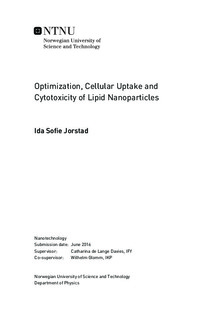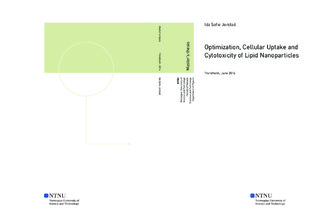| dc.description.abstract | Chemotherapy can potentially be greatly improved by using nanoparticles as drug carriers to deliver chemotherapeutic drugs specifically to cancer cells. Lipid nanoparticles can encapsulate hydrophobic drugs that have low solubility in water, and target tumor sites in the body either by active, passive or triggered delivery. In this thesis, nanoparticle stability and size is optimized from an already existing lipid particle formulation that is based on a mixture of solid (stearic acid) and liquid lipid (isopropyl palmitate). Systematic screening of the particle formulation and synthesis process parameters led to the development of a nanostructured lipid carrier particle stabilized by a combination of surfactants, Andean QDP Ultra and Phospholipon 80H. Zetasizer has been used to analyze size and stability of the monodisperse lipid nanoparticles. \\
In the second part of the project, flow cytometry was used to characterize cellular uptake of fluorescently labeled lipid nanoparticles. It was found that particle degradation extracellularly followed by release of dye and diffusion across the cell membrane is likely the main mechanism of fluorophore uptake. Both rate of uptake found from flow cytometry analysis, and stability analysis from the particle optimization process, indicates lipid particle degradation occuring over a time period of at least 48 hours in a physiological environment. \\
Lastly, cytotoxicity of lipid nanoparticles and nanoparticle encapsulated kinase inhibitor was investigated \textit{in vitro}. The kinase inhibitor, Gefitinib showed time and concentration dependent cytotoxicity, while the nanoparticles had very high toxicity. Even at concentrations as low as $\approx$15$\mu$g/ml empty nanoparticles in growth media, the cell viability was less than 80\%. | |

